Articulatory classification of English vowels Vowels

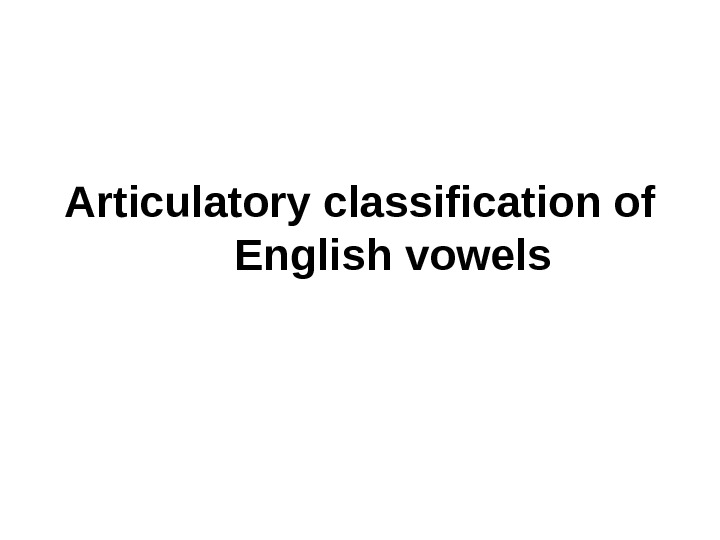
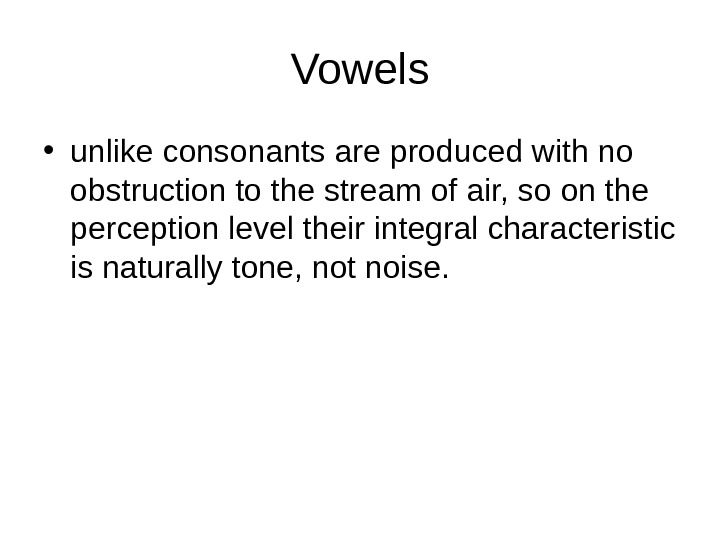
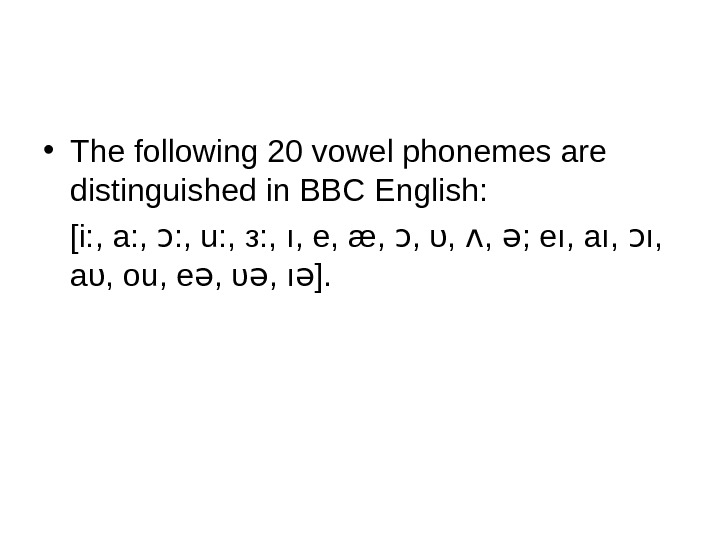
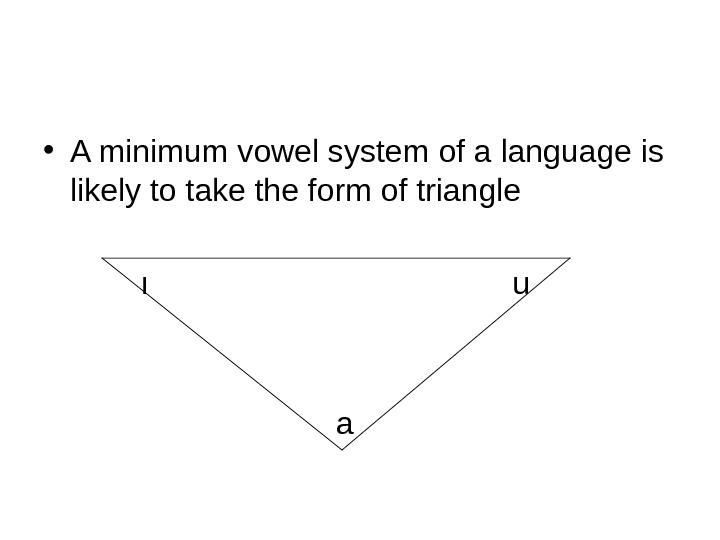
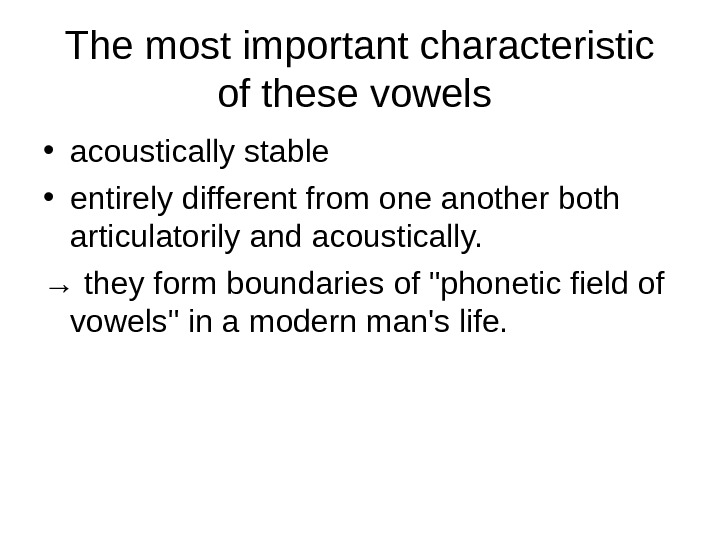
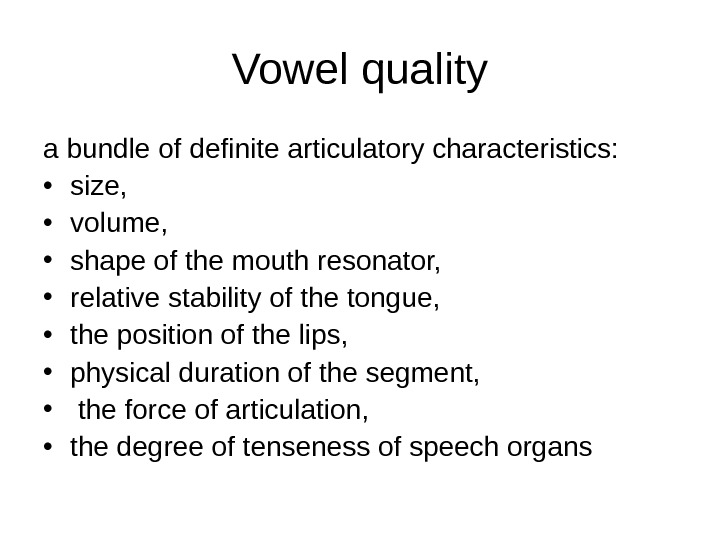
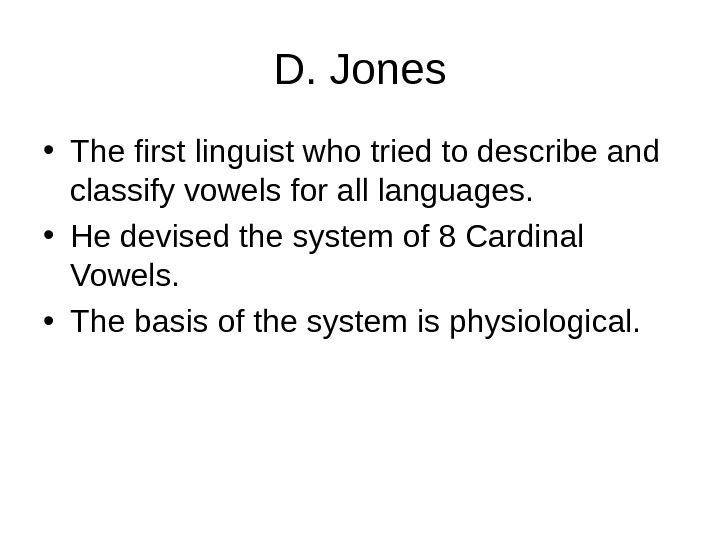
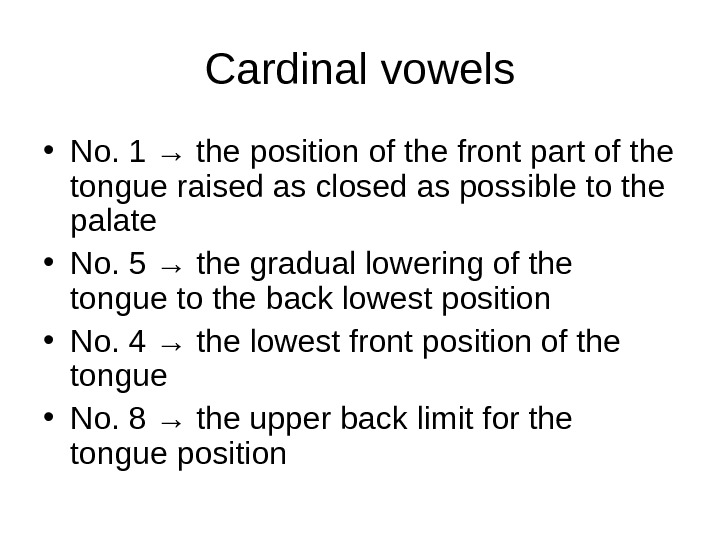
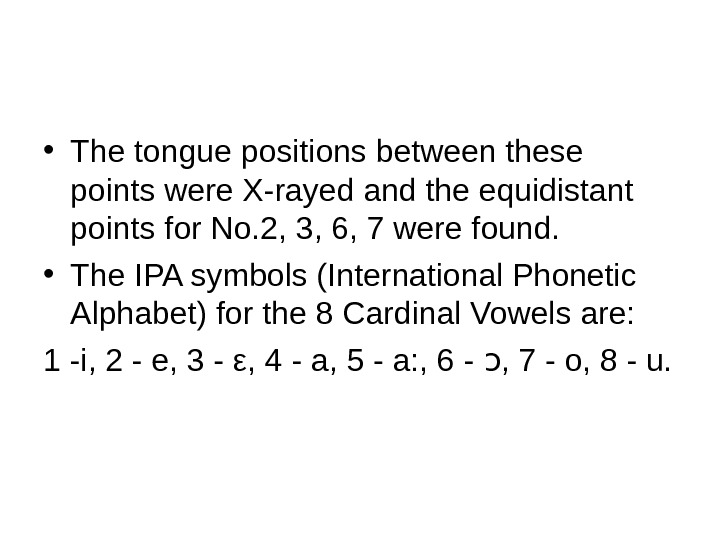
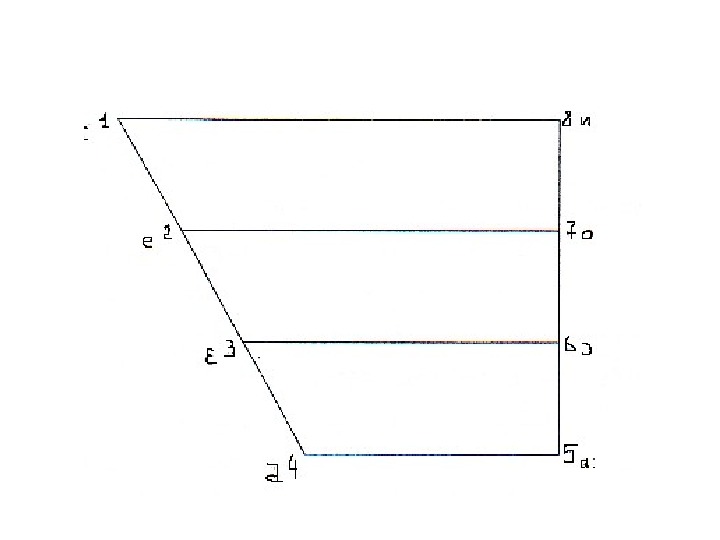
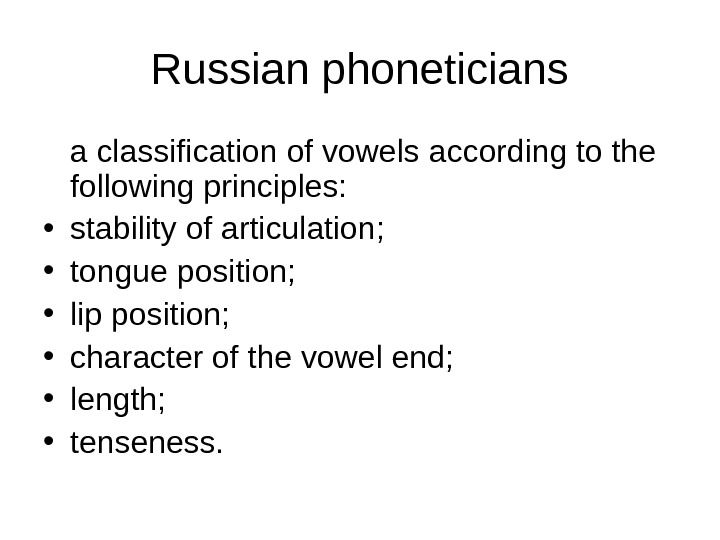
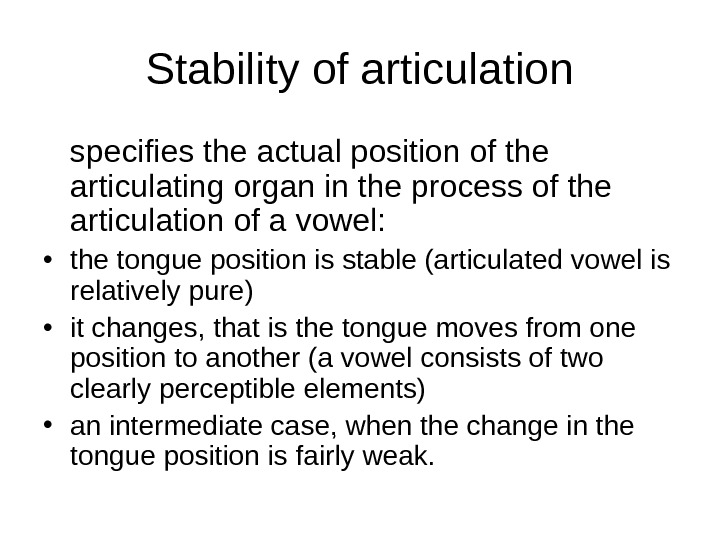
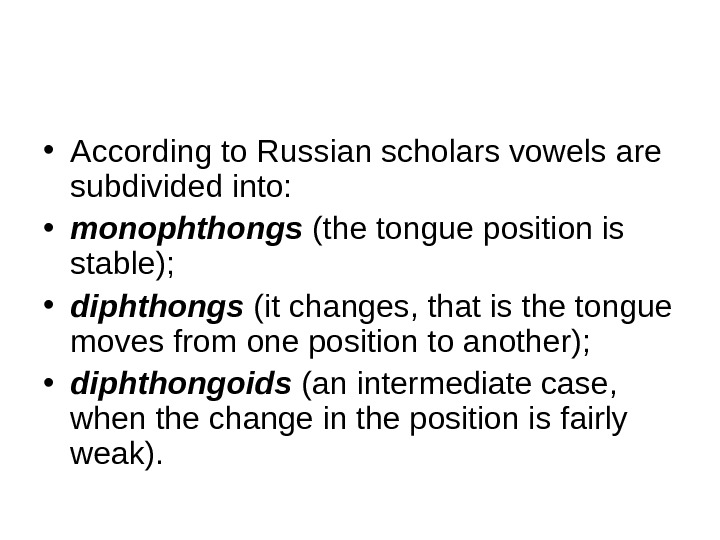
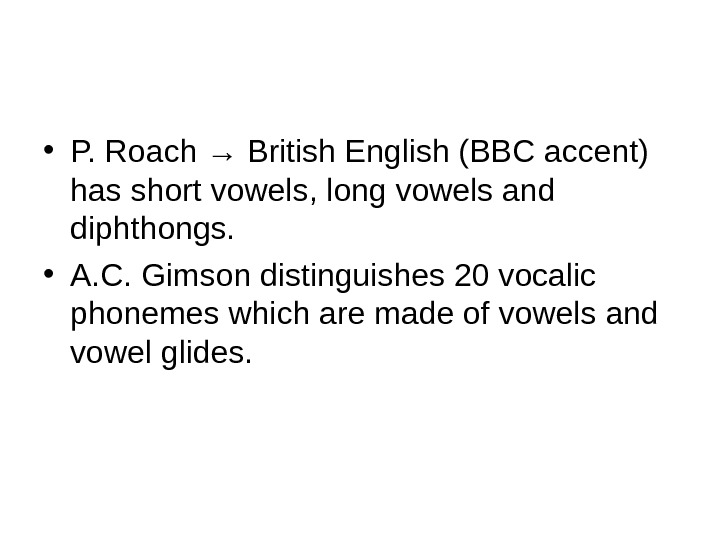
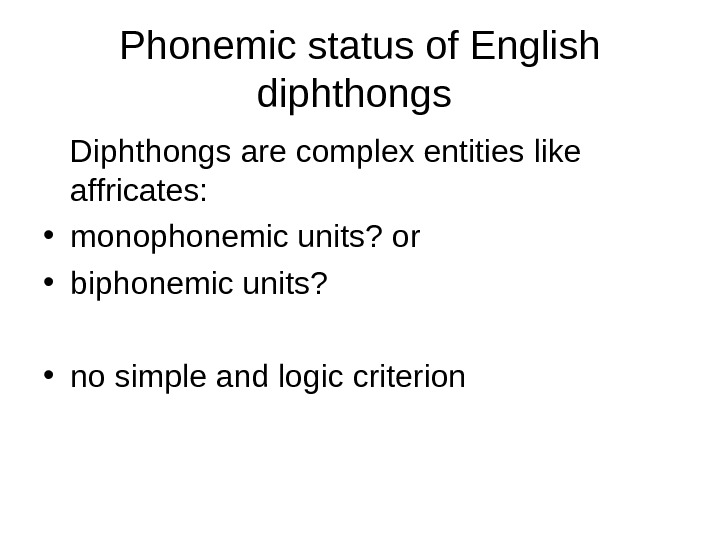
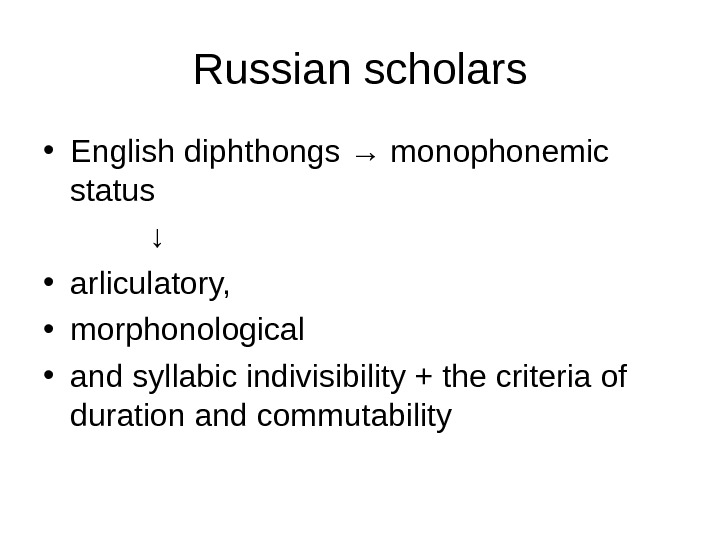
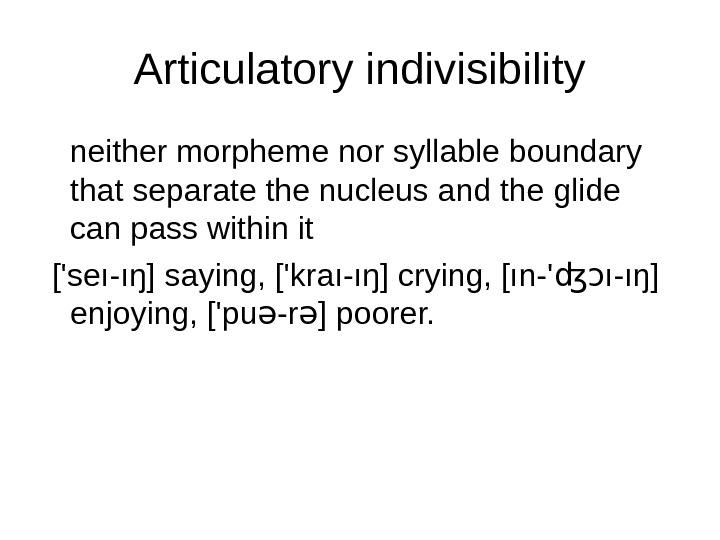
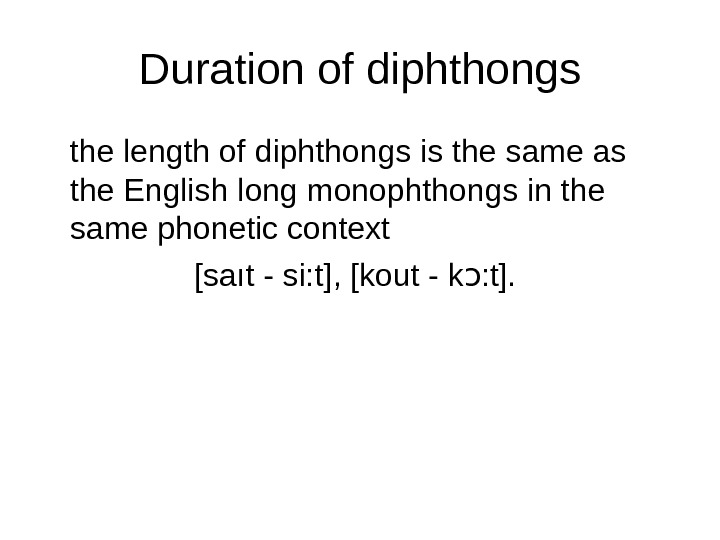
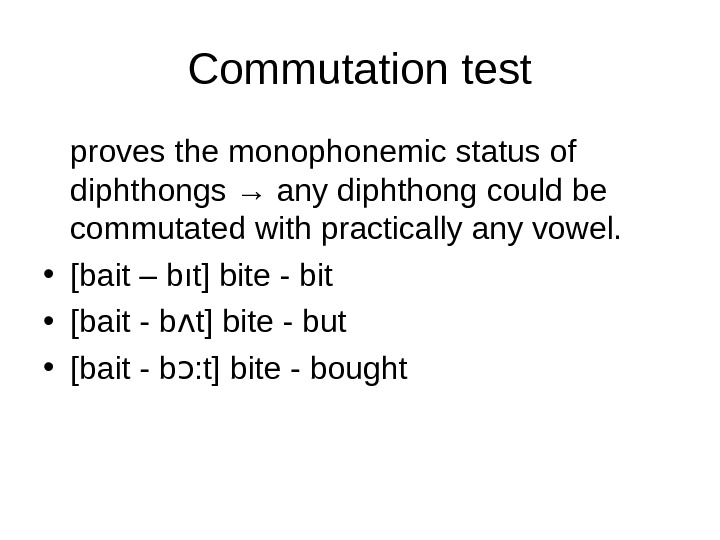
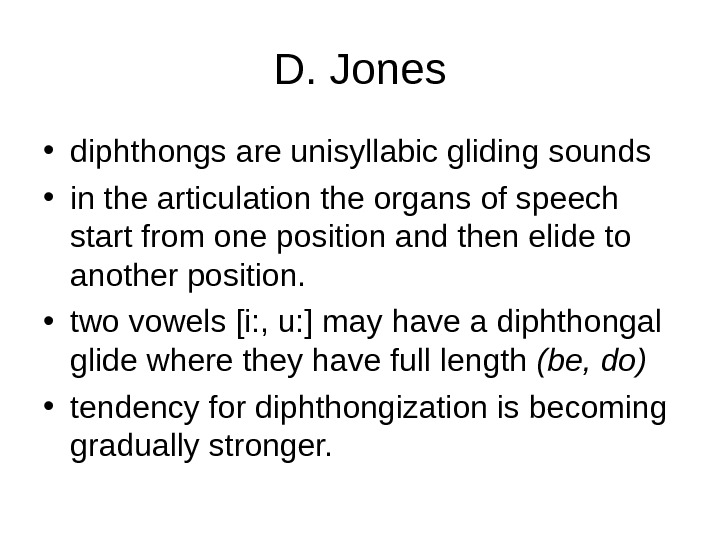
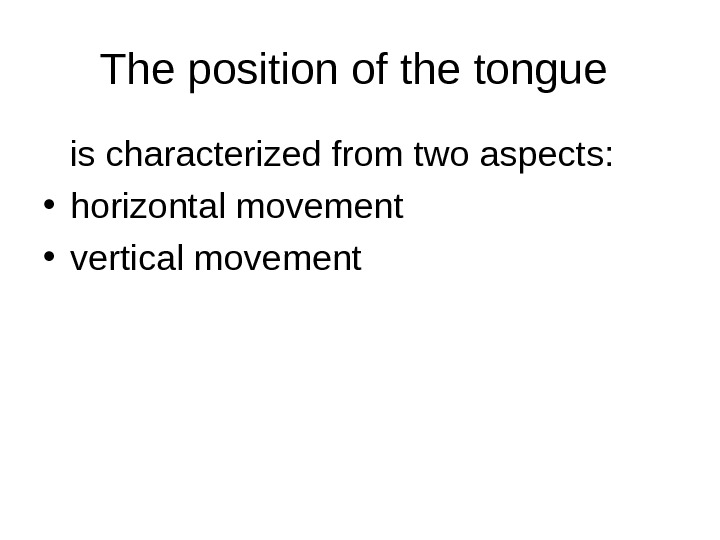
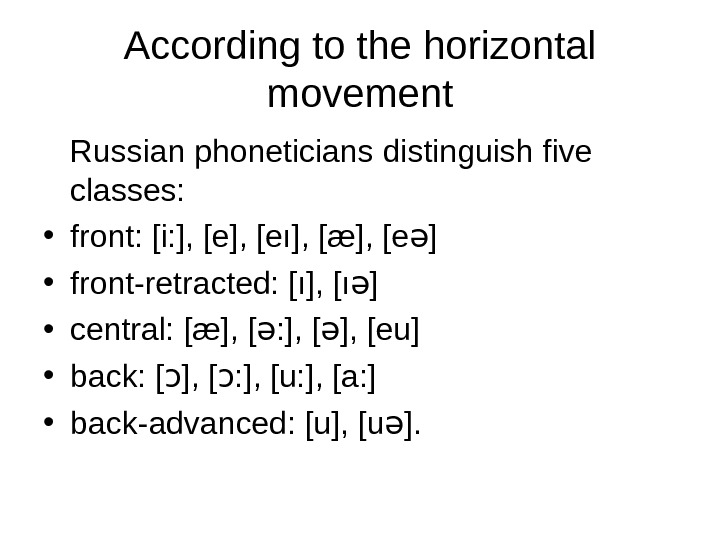
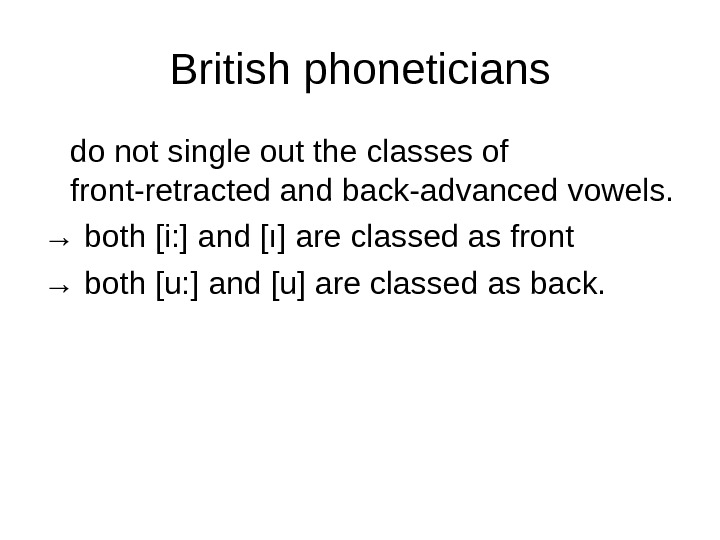
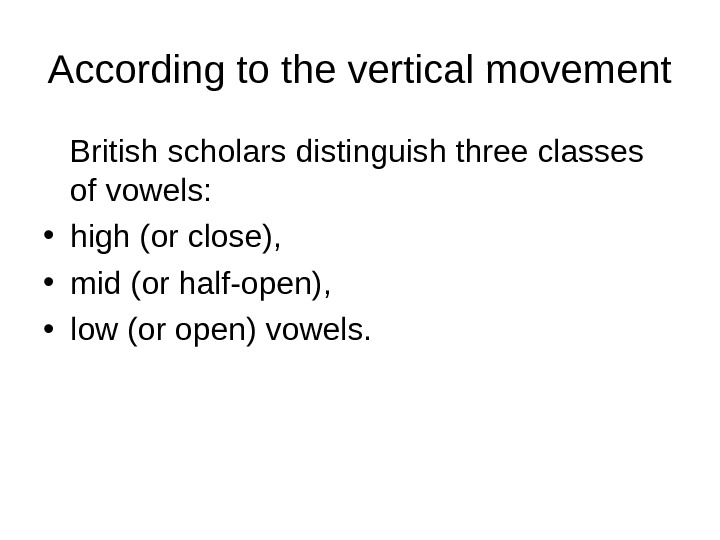
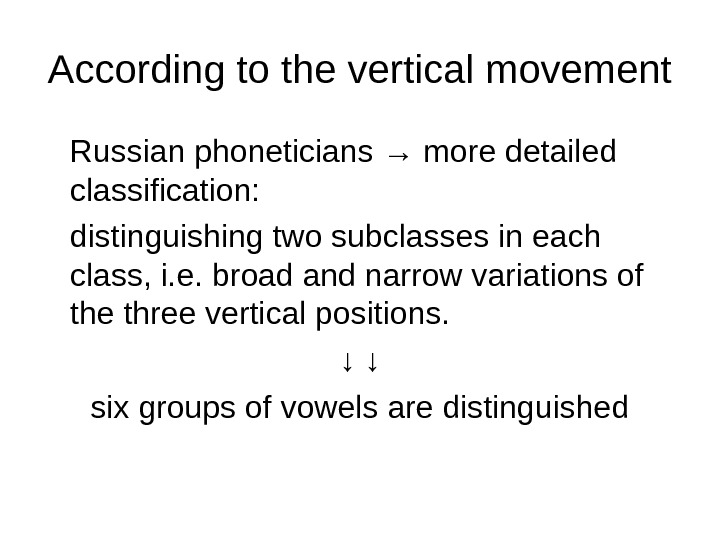
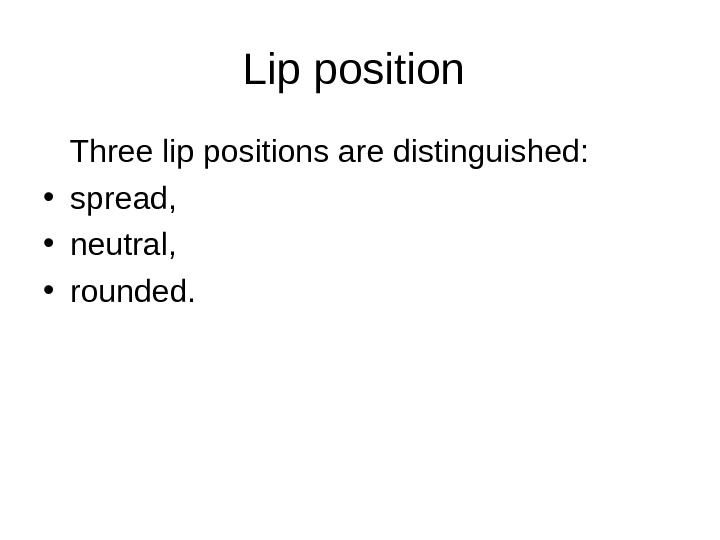
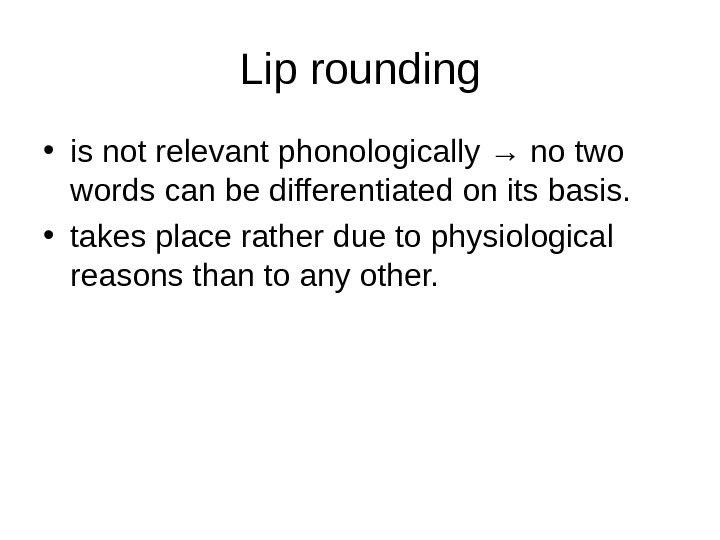
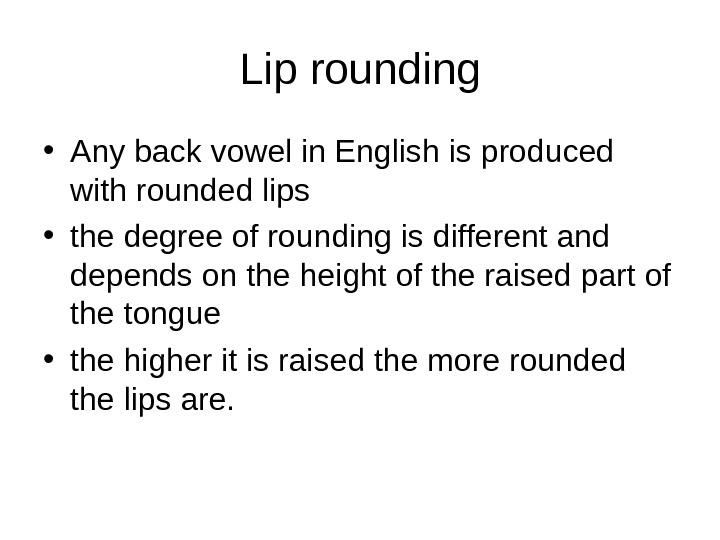
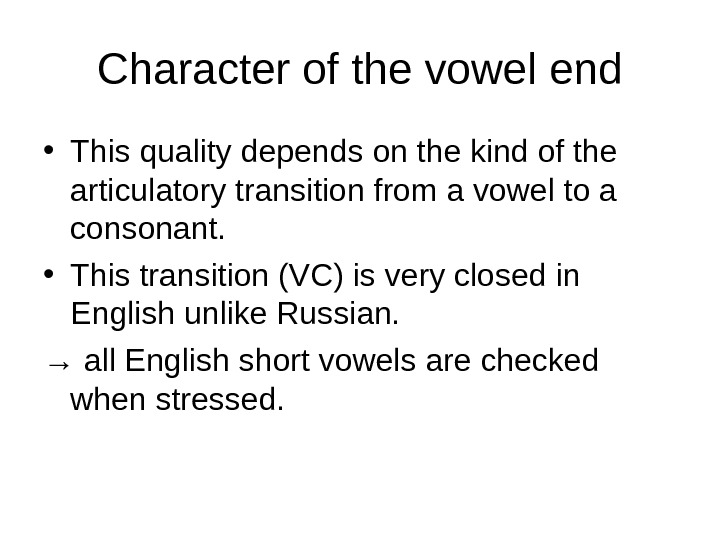
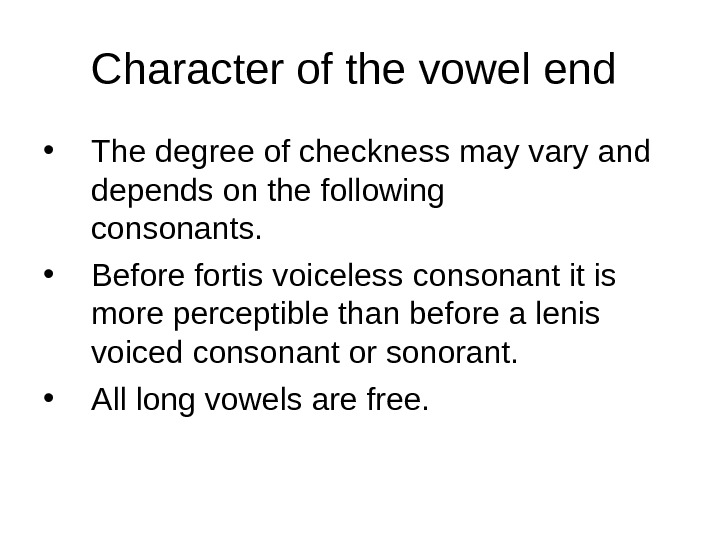
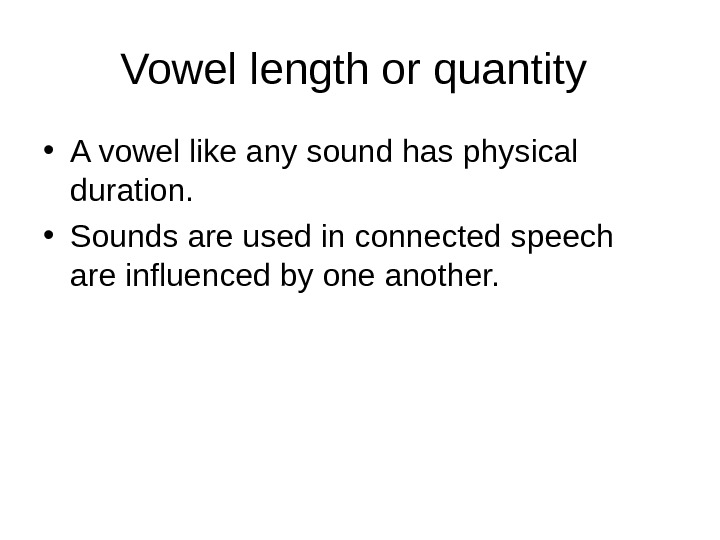
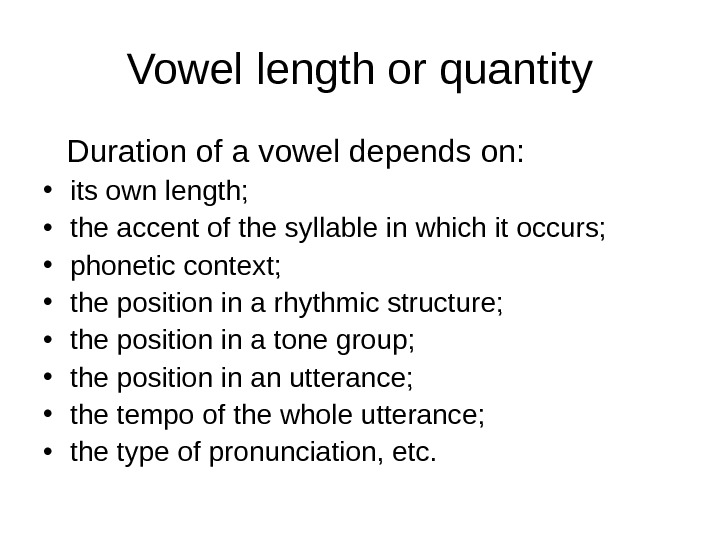

4_slassification_of_english_vowels.ppt
- Размер: 107 Кб
- Количество слайдов: 33
Описание презентации Articulatory classification of English vowels Vowels по слайдам
 Articulatory classification of English vowels
Articulatory classification of English vowels
 Vowels • unlike consonants are produced with no obstruction to the stream of air, so on the perception level their integral characteristic is naturally tone, not noise.
Vowels • unlike consonants are produced with no obstruction to the stream of air, so on the perception level their integral characteristic is naturally tone, not noise.
 • The following 20 vowel phonemes are distinguished in BBC English: [i: , a: , u: , ɔ з : , ı, e, æ, , υ, ɔ ʌ , ; eı, aı, ı, ə ɔ а υ, ou, e , υ , ı ]. ǝ ə ə
• The following 20 vowel phonemes are distinguished in BBC English: [i: , a: , u: , ɔ з : , ı, e, æ, , υ, ɔ ʌ , ; eı, aı, ı, ə ɔ а υ, ou, e , υ , ı ]. ǝ ə ə
 • A minimum vowel system of a language is likely to take the form of triangle ı u a
• A minimum vowel system of a language is likely to take the form of triangle ı u a
 The most important characteristic of these vowels • acoustically stable • entirely different from one another both articulatorily and acoustically. → they form boundaries of «phonetic field of vowels» in a modern man’s life.
The most important characteristic of these vowels • acoustically stable • entirely different from one another both articulatorily and acoustically. → they form boundaries of «phonetic field of vowels» in a modern man’s life.
 Vowel quality a bundle of definite articulatory characteristics: • size, • volume, • shape of the mouth resonator, • relative stability of the tongue, • the position of the lips, • physical duration of the segment, • the force of articulation, • the degree of tenseness of speech organs
Vowel quality a bundle of definite articulatory characteristics: • size, • volume, • shape of the mouth resonator, • relative stability of the tongue, • the position of the lips, • physical duration of the segment, • the force of articulation, • the degree of tenseness of speech organs
 D. Jones • The first linguist who tried to describe and classify vowels for all languages. • He devised the system of 8 Cardinal Vowels. • The basis of the system is physiological.
D. Jones • The first linguist who tried to describe and classify vowels for all languages. • He devised the system of 8 Cardinal Vowels. • The basis of the system is physiological.
 Cardinal vowels • No. 1 → the position of the front part of the tongue raised as closed as possible to the palate • No. 5 → the gradual lowering of the tongue to the back lowest position • No. 4 → the lowest front position of the tongue • No. 8 → the upper back limit for the tongue position
Cardinal vowels • No. 1 → the position of the front part of the tongue raised as closed as possible to the palate • No. 5 → the gradual lowering of the tongue to the back lowest position • No. 4 → the lowest front position of the tongue • No. 8 → the upper back limit for the tongue position
 • The tongue positions between these points were X-rayed and the equidistant points for No. 2, 3, 6, 7 were found. • The IPA symbols (International Phonetic Alphabet) for the 8 Cardinal Vowels are: 1 -i, 2 — e, 3 — ε, 4 — a, 5 — a: , 6 — , 7 — o, 8 — u. ɔ
• The tongue positions between these points were X-rayed and the equidistant points for No. 2, 3, 6, 7 were found. • The IPA symbols (International Phonetic Alphabet) for the 8 Cardinal Vowels are: 1 -i, 2 — e, 3 — ε, 4 — a, 5 — a: , 6 — , 7 — o, 8 — u. ɔ

 Russian phoneticians a classification of vowels according to the following principles: • stability of articulation; • tongue position; • lip position; • character of the vowel end; • length; • tenseness.
Russian phoneticians a classification of vowels according to the following principles: • stability of articulation; • tongue position; • lip position; • character of the vowel end; • length; • tenseness.
 Stability of articulation specifies the actual position of the articulating organ in the process of the articulation of a vowel: • the tongue position is stable (articulated vowel is relatively pure) • it changes, that is the tongue moves from one position to another (a vowel consists of two clearly perceptible elements) • an intermediate case, when the change in the tongue position is fairly weak.
Stability of articulation specifies the actual position of the articulating organ in the process of the articulation of a vowel: • the tongue position is stable (articulated vowel is relatively pure) • it changes, that is the tongue moves from one position to another (a vowel consists of two clearly perceptible elements) • an intermediate case, when the change in the tongue position is fairly weak.
 • According to Russian scholars vowels are subdivided into: • monophthongs (the tongue position is stable); • diphthongs (it changes, that is the tongue moves from one position to another); • diphthongoids (an intermediate case, when the change in the position is fairly weak).
• According to Russian scholars vowels are subdivided into: • monophthongs (the tongue position is stable); • diphthongs (it changes, that is the tongue moves from one position to another); • diphthongoids (an intermediate case, when the change in the position is fairly weak).
 • P. Roach → British English (BBC accent) has short vowels, long vowels and diphthongs. • A. C. Gimson distinguishes 20 vocalic phonemes which are made of vowels and vowel glides.
• P. Roach → British English (BBC accent) has short vowels, long vowels and diphthongs. • A. C. Gimson distinguishes 20 vocalic phonemes which are made of vowels and vowel glides.
 Phonemic status of English diphthongs Diphthongs are complex entities like affricates: • monophonemic units? or • biphonemic units? • no simple and logic criterion
Phonemic status of English diphthongs Diphthongs are complex entities like affricates: • monophonemic units? or • biphonemic units? • no simple and logic criterion
 Russian scholars • English diphthongs → monophonemic status ↓ • arliculatory, • morphonological • and syllabic indivisibility + the criteria of duration and commutability
Russian scholars • English diphthongs → monophonemic status ↓ • arliculatory, • morphonological • and syllabic indivisibility + the criteria of duration and commutability
 Articulatory indivisibility neither morpheme nor syllable boundary that separate the nucleus and the glide can pass within it [‘seı-ıŋ] saying, [‘kraı-ıŋ] crying, [ın-‘ ı-ıŋ] ʤɔ enjoying, [‘pu -r ] poorer. ǝ ǝ
Articulatory indivisibility neither morpheme nor syllable boundary that separate the nucleus and the glide can pass within it [‘seı-ıŋ] saying, [‘kraı-ıŋ] crying, [ın-‘ ı-ıŋ] ʤɔ enjoying, [‘pu -r ] poorer. ǝ ǝ
 Duration of diphthongs the length of diphthongs is the same as the English long monophthongs in the same phonetic context [saıt — si: t], [kout — k : t]. ɔ
Duration of diphthongs the length of diphthongs is the same as the English long monophthongs in the same phonetic context [saıt — si: t], [kout — k : t]. ɔ
 Commutation test proves the monophonemic status of diphthongs → any diphthong could be commutated with practically any vowel. • [bait – bıt] bite — bit • [bait — b t] bite — but ʌ • [bait — b : t] bite — bought ɔ
Commutation test proves the monophonemic status of diphthongs → any diphthong could be commutated with practically any vowel. • [bait – bıt] bite — bit • [bait — b t] bite — but ʌ • [bait — b : t] bite — bought ɔ
 D. Jones • diphthongs are unisyllabic gliding sounds • in the articulation the organs of speech start from one position and then elide to another position. • two vowels [i: , u: ] may have a diphthongal glide where they have full length (be, do) • tendency for diphthongization is becoming gradually stronger.
D. Jones • diphthongs are unisyllabic gliding sounds • in the articulation the organs of speech start from one position and then elide to another position. • two vowels [i: , u: ] may have a diphthongal glide where they have full length (be, do) • tendency for diphthongization is becoming gradually stronger.
 The position of the tongue is characterized from two aspects: • horizontal movement • vertical movement
The position of the tongue is characterized from two aspects: • horizontal movement • vertical movement
![According to the horizontal movement Russian phoneticians distinguish five classes: • front: [i: ], [eı], According to the horizontal movement Russian phoneticians distinguish five classes: • front: [i: ], [eı],](/docs//4_slassification_of_english_vowels_images/4_slassification_of_english_vowels_21.jpg) According to the horizontal movement Russian phoneticians distinguish five classes: • front: [i: ], [eı], [æ], [e ]ǝ • front-retracted: [ı], [ı ] ǝ • central: [æ], [ : ], [eu] ǝ ǝ • back: [ ], [ : ], [u: ], [a: ] ɔ ɔ • back-advanced: [u], [u ]. ǝ
According to the horizontal movement Russian phoneticians distinguish five classes: • front: [i: ], [eı], [æ], [e ]ǝ • front-retracted: [ı], [ı ] ǝ • central: [æ], [ : ], [eu] ǝ ǝ • back: [ ], [ : ], [u: ], [a: ] ɔ ɔ • back-advanced: [u], [u ]. ǝ
 British phoneticians do not single out the classes of front-retracted and back-advanced vowels. → both [i: ] and [ı] are classed as front → both [u: ] and [u] are classed as back.
British phoneticians do not single out the classes of front-retracted and back-advanced vowels. → both [i: ] and [ı] are classed as front → both [u: ] and [u] are classed as back.
 According to the vertical movement British scholars distinguish three classes of vowels: • high (or close), • mid (or half-open), • low (or open) vowels.
According to the vertical movement British scholars distinguish three classes of vowels: • high (or close), • mid (or half-open), • low (or open) vowels.
 According to the vertical movement Russian phoneticians → more detailed classification: distinguishing two subclasses in each class, i. e. broad and narrow variations of the three vertical positions. ↓ ↓ six groups of vowels are distinguished
According to the vertical movement Russian phoneticians → more detailed classification: distinguishing two subclasses in each class, i. e. broad and narrow variations of the three vertical positions. ↓ ↓ six groups of vowels are distinguished
 Lip position Three lip positions are distinguished: • spread, • neutral, • rounded.
Lip position Three lip positions are distinguished: • spread, • neutral, • rounded.
 Lip rounding • is not relevant phonologically → no two words can be differentiated on its basis. • takes place rather due to physiological reasons than to any other.
Lip rounding • is not relevant phonologically → no two words can be differentiated on its basis. • takes place rather due to physiological reasons than to any other.
 Lip rounding • Any back vowel in English is produced with rounded lips • the degree of rounding is different and depends on the height of the raised part of the tongue • the higher it is raised the more rounded the lips are.
Lip rounding • Any back vowel in English is produced with rounded lips • the degree of rounding is different and depends on the height of the raised part of the tongue • the higher it is raised the more rounded the lips are.
 Character of the vowel end • This quality depends on the kind of the articulatory transition from a vowel to a consonant. • This transition (VC) is very closed in English unlike Russian. → all English short vowels are checked when stressed.
Character of the vowel end • This quality depends on the kind of the articulatory transition from a vowel to a consonant. • This transition (VC) is very closed in English unlike Russian. → all English short vowels are checked when stressed.
 Character of the vowel end • The degree of checkness may vary and depends on the following consonants. • Before fortis voiceless consonant it is more perceptible than before a lenis voiced consonant or sonorant. • All long vowels are free.
Character of the vowel end • The degree of checkness may vary and depends on the following consonants. • Before fortis voiceless consonant it is more perceptible than before a lenis voiced consonant or sonorant. • All long vowels are free.
 Vowel length or quantity • A vowel like any sound has physical duration. • Sounds are used in connected speech are influenced by one another.
Vowel length or quantity • A vowel like any sound has physical duration. • Sounds are used in connected speech are influenced by one another.
 Vowel length or quantity Duration of a vowel depends on: • its own length; • the accent of the syllable in which it occurs; • phonetic context; • the position in a rhythmic structure; • the position in a tone group; • the position in an utterance; • the tempo of the whole utterance; • the type of pronunciation, etc.
Vowel length or quantity Duration of a vowel depends on: • its own length; • the accent of the syllable in which it occurs; • phonetic context; • the position in a rhythmic structure; • the position in a tone group; • the position in an utterance; • the tempo of the whole utterance; • the type of pronunciation, etc.
 Tenseness characterizes the state of the organs of speech at the moment of vowel production ↓ ↓ historically long vowels are tense while historically short are lax
Tenseness characterizes the state of the organs of speech at the moment of vowel production ↓ ↓ historically long vowels are tense while historically short are lax

